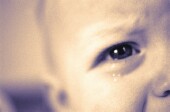
WEDNESDAY, April 13 (HealthDay News) — Recession-related stress may have triggered an alarming increase in non-accidental head injuries among infants, new research suggests.
The number of babies hospitalized for non-accidental head trauma — a form of child abuse previously known as shaken baby syndrome — doubled during the recent recession, according to the study by researchers at University Hospitals Rainbow Babies and Children’s Hospital in Cleveland.
“The reasons for why this is happening are beyond the scope of our study, but it may be that more parents are stressed to the breaking point because of economic problems like unemployment and foreclosures,” said lead author Mary I. Huang, a fourth-year medical student at Case Western Reserve University School of Medicine.
“In many cases, when people are forced to leave their homes, they may be moving in with relatives who might not have as much of a vested interest in taking care of infants,” added Huang, who is scheduled to present the paper Wednesday at the American Association of Neurological Surgeons’ meeting in Denver. Research presented at meetings is considered preliminary until it is published in a peer-reviewed journal.
The new findings echo a 2010 study by researchers at the University of Pittsburgh. That paper evaluated cases of non-accidental head injury among infants and young children from 2004 through 2009 in four urban children’s hospitals. The researchers found almost twice as many cases of abusive head trauma per month in the recession period — starting in December 2007 — compared with the period prior to the recession.
The idea for the study came to Huang during her third-year rotation on the pediatric neurosurgery service. “Some of the doctors mentioned that we’d been seeing a lot of non-accidental head trauma, and they wondered if it could have anything to do with the recession,” Huang said. “I thought this would be a great question to explore using our trauma registry.”
Huang and her colleagues reviewed the hospital’s database for cases of non-accidental head trauma (NAHT) in children up to 2 years old from December 2001 through June 2010. During that time, 639 infants under the age of 2 were admitted for traumatic injuries, and 93 of the cases were classified as NAHT.
A total of 43 cases of NAHT occurred in the 31 months of the recession period (December 2007 through June 2010), compared with 50 cases during the 72 months of the non-recession period (December 2001 through November 2007), which represented a 101 percent increase.
Significantly more serious injuries were also noted during the recession, resulting in more deaths and cases of severe brain injury, the research team found.
“We really weren’t expecting to see such a big increase,” Huang noted. “It was pretty startling for all of us.”
During the recession, overall traumas decreased by 8.2 percent, and accidental infant head traumas went down 3.5 percent, but the proportion of months in which at least one infant was admitted for NAHT was 58 percent greater than during the non-recession period.
Pediatric care providers need to be aware of the rise in child abuse during economic downturns and screen appropriately, the authors said.
Dr. Robert Block, professor and chair of pediatrics at the University of Oklahoma Health Sciences Center, said the study findings weren’t surprising.
“We know that times of increased stress may be more dangerous for babies,” he said, “and so it makes sense that in a recession, where there are all kinds of very stressful situations, we would see an uptick in these kinds of injuries.”
Block, who is president-elect of the American Academy of Pediatrics, speculated that cuts to social services programs in recent years may have also been a factor.
“Cutting services that support children and families is a terribly wrong-headed move,” said Block, “because the babies who are affected, if they survive, will have lifelong consequences as a result of this violent abuse.”
More information
The U.S. Department of Health and Human Services has more on preventing child abuse.

